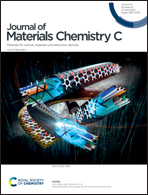A luminescent 2,1,3-benzoxadiazole-decorated zirconium-organic framework as an exceptionally sensitive turn-on sensor for ammonia and aliphatic amines in water†
Abstract
A new dicarboxylate ligand - 4,7-di(p-carboxyphenyl)-2,1,3-benzoxadiazole was synthesised and used for the preparation of the 2,1,3-benzoxadiazole-decorated zirconium(IV)-based metal–organic framework UiO-68(bod). Single-crystal X-ray diffraction analysis revealed it to belong to the UiO-68 family with fcu topology. The framework UiO-68(bod) exhibited a high photoluminescence quantum yield (35%) and a strong fluorescence turn-on response to ammonia and aliphatic amines in water. The detection limits of the amines were in the range of 60–240 nM, while for ammonia the detection limit was as low as 6.5 ppb (384 nM), which is the best value among the MOFs sensitive to NH3 in aqueous solutions. The mechanism behind the response was rationalised on the basis of DFT calculations. Paper test-strips for the simple and express detection of ammonia/amines in water were fabricated.



 Please wait while we load your content...
Please wait while we load your content...